#natural nucifera
Explore tagged Tumblr posts
Text
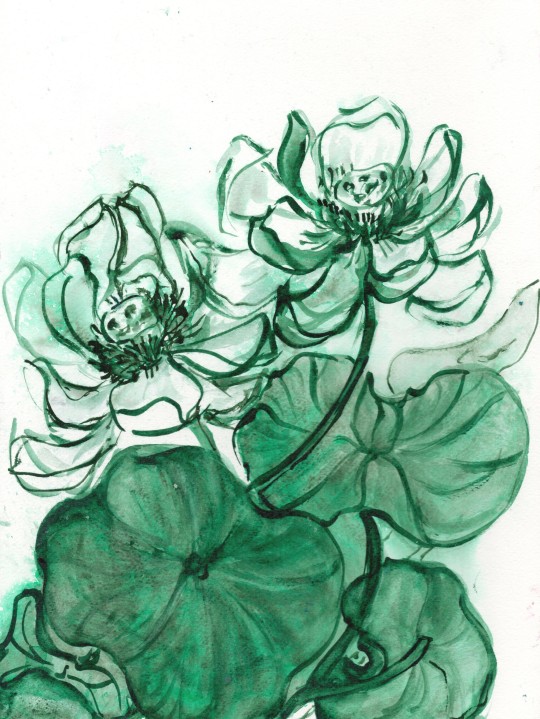
Muddy Waters Grow Beautifully
Watercolor on Artboard
2023, 9"x 12"
Lotus Blossoms, Nelumbo nuclfera
Jadeite
#art#nature#flowers#artists on tumblr#floral#watercolor#painting#minimalism#jadeite#green#lotus#lotuses#white flowers#nelumbo#nelumbo nucifera#white#minimal#water#water plants#plants#aquatic plants#botany#artwork
344 notes
·
View notes
Text

Lotus Vibes
#digital art#illustration#procreate#drawing#aesthetic#art#art therapy#artists on tumblr#digital artist#lotus#vibes#lotus flower#flowers#lotus vibes#nelumbo nucifera#sacred lotus#plants#dark aesthetic#naturecore#nature#nature drawing#water plants#divine feminine#feminine energy#energy#neon#neoncore
36 notes
·
View notes
Text

ig - afternoondreams
#kelli soukup#nature#photography#botany#botanical#summer#plants#lotus#flowers#floral#flora#august#september#nelumbo nucifera#nelumbo nucifera lotus flowers#peaceful#calming#water#dreamy#art#aesthetic#sunshine#magical#cinematic#photographers#sunlight#nature photography#lotus flower#lotus flowers
140 notes
·
View notes
Text
Módào Zǔshī Hanakotoba Analysis Part 2
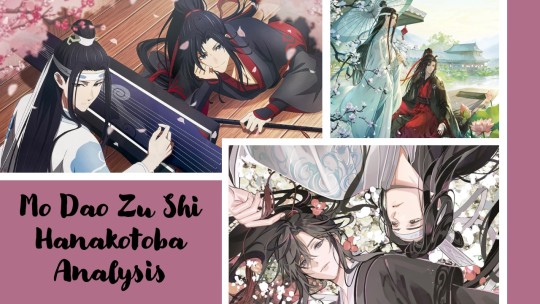
◤━━━━━━━━━◥✿◤━━━━━━━━━◥
-> 4) Lotus/Water Lily



-> 4.1.) Lotus/Water Lily Flower Symbolism:
Despite having a few differentiating characteristics, lotuses (Nelumbo nucifera) and water lilies (Nymphaea) are often confused with one another. As a result, there is a lot of overlap in their symbolic meanings, to the point that they convey the same sentiments across multiple cultures. In China, lotuses are known as lián huā (蓮花) or hé huā (荷花), whereas water lilies are known as shuìlián (睡莲) and héhuā (荷花). Lotuses are known as the "gentleman's flower" in China because they grow upwards pure and unstained from the mud. The flower is thus associated with perseverance, elegance, resilience, as well as ultimate purity of mind and heart. The lotus is revered as a sacred flower in Buddhism, representing the essence of divine beauty, wisdom, humility grace and rebirth. It is also a sign of moral integrity, emphasising the importance of maintaining inner purity and virtuous behaviour in the face of worldly temptations. The word “l蓮” (lián) also sounds like “連續” (liánxù) which means continuous. This conveys the idea of constant growth and spiritual progress thus making the lotus a symbol of the continuous pursuit of knowledge, wisdom, and enlightenment. The lotus also has profound significance in Taoism, representing serenity, balance, and the "interconnectedness of all things and the inherent harmony within the universe". The lotus' adaptability to various environments embodies the Taoist concept of living in harmony with nature, flowing with life's rhythms, and preserving equilibrium in the face of change. Additionally, the lotus' ability to rejuvenate and blossom year after year, despite the shifting seasons, represents the continuous cycle of life, death, and rebirth. Part of the lotus flower’s Chinese name “l蓮” (lián) is homophonous with the words “聯” (lián) meaning “to bind/connect as in marriage”; “戀” (liàn) meaning to love; and “廉” (lián) meaning modesty. As a result, the lotus flower has also come to symbolise union, love and marriage in Chinese culture and is thus a prominent motif in both historical and modern works to convey love and emotion. Lotuses are commonly used in bridal bouquets as a symbol of luck and 100 years of love. A single stem bearing two lotus flowers represents the desire for harmony and a shared heart. This is derived from the fact that the “荷” (hé) in the lotus’ other Chinese name also means “union” and is homophonous with the word “和” (hé) meaning uninterrupted or one after another. Furthermore, a lotus flower with a leaf and bud symbolises complete union. In Japan, lotuses are called ren (蓮) or hasu (はす), while water lilies are called suiren (睡蓮). In hanakotoba, lotuses symbolise a pure heart, eloquence, sacredness and departing love—while water lilies symbolise a pure heart, faith and trust. Additionally, both flowers are also associated with rebirth, transformation, enlightenment, beauty, grace, and perfection. In Western floriography, water lilies symbolize purity of the heart, virtue, innocence, achieving great things, beauty rising from humble beginnings and bringing together separate things. Pink waterlilies are commonly associated with feelings of admiration. Since its scientific name was derived from the mythical Greek nymph, water lilies also symbolise dangerous beauty and estranged love.
-> 4.2.) Lotus'/Water Lilies in MDZS:
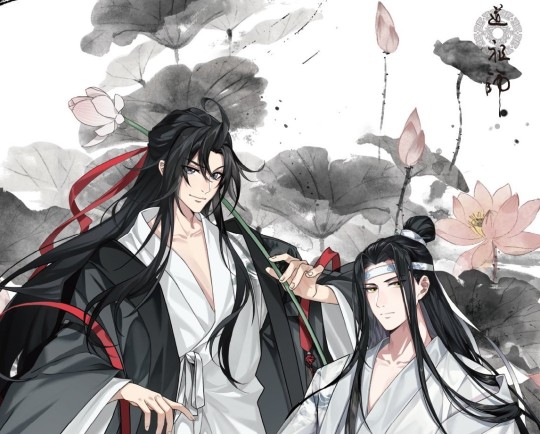

Lotuses are the most commonly referenced flower in MDZS, and they are generally associated with the Yunmeng Jiang clan. This is due to the clan's insignia, a nine-petaled lotus, as well as the name of their residence, Lotus Pier. According to the novel, the compound is surrounded by “pink blossoms with broad jade-green leaves rose from the depths of the lake, whose waters spanned hundreds of kilometres […] giving the lovely scenery a sort of charming innocence” (MXTX, v. 3, p. 9).
The lotus’ symbolic meanings best embody the characters of Jiang Yanli and Wei Wuxian. > 4,2,1) Jiang Yanli: The flower's symbolic representation of virtue, modesty, innocence, beauty, faith, grace, and purity of the heart perfectly conveys Jiang Yanli's kind and caring demeanour. Jiang Yanli's relationship with Jin Zixuan is a key aspect of her character. The lotus' symbolism of love, union, marriage, and a shared heart corresponds with this. Additionally, in both the web drama and MDZS Q, Jin Zixuan grows lotus flowers as a gift for Jin Yanli. > 4,2,2) Wei Wuxian: Wei Wuxian's life can be divided into three parts: his time as the first disciple of the Jiang clan, his time as the Yiling Laozu, and his life after his resurrection as Mo Xuanyu. During his youth with the Jiang clan, he was a promising upcoming cultivator with a humble background. Despite displaying a mischievous and carefree attitude, he was intelligent, dedicated, virtuous and possessed a strong sense of justice. This ties into the lotus’ symbolism of flowing with life's rhythms, wisdom, perseverance, virtue and beauty from humble beginnings. As the Yiling Laozu, he defies convention by developing an unorthodox cultivation path that deviates from the norm. This corresponds with the lotus' symbolism of the continuous pursuit of knowledge, wisdom and achieving great things. He is determined to protect the innocent regardless of prejudicial beliefs—however, this sense of justice renders him capable of brutality at times. This is what inevitably results in him being seen as an outcast in the cultivation world. Ultimately, his power overwhelms him, causing many casualties given that “no one can walk along a single-plank bridge their entire lives and never fall” (MXTX, v. 2, p. 173). This turn of events all juxtaposed against the lotus’ symbolism of preserving stability in the face of change and achieving ultimate purity of mind and heart. After his resurrection, as a result of his experiences as both a hero and a pariah to the cultivation world, Wei Wuxian sees nuance where many do not and often expresses regret and admits his faults—“You’re not the only ones who remember what I’ve done. I remember too. You won’t forget—what makes you think I will?” (MXTX, v. 4, p. 174). This ties into the lotus’ symbolism of wisdom, constant growth and spiritual progress as well as the continuous cycle of life, death, and rebirth. Additionally, his courtesy name Wuxian (无羡) is derived from the last line of a poem by Xu Ben which translates to “to be free of envy and aspire to greater heights; not be misguided by honorary reputation and personal gain”. This ties into the lotus’ symbolism of maintaining inner purity and virtuous behaviour in the face of worldly temptations.
-> 5) Peony
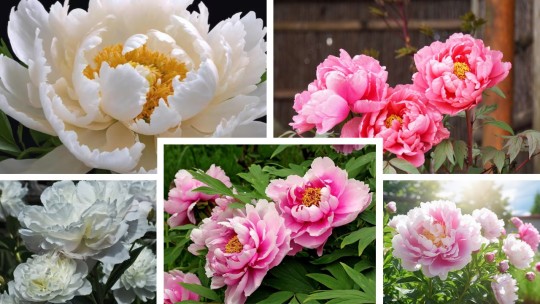


-> 5.1.) Peony Symbolism:
Peonies (Paeonia) are known as mǔdān (牡丹) in China and were regarded as China’s national flower during the Tang Dynasty (618 to 907 A.D.). In accordance with this, they symbolise prosperity, honour, wealth and beauty, love and happiness. The Chinese term for peonies means "the most beautiful” while other Chinese names for peonies are "fùguìhuā" and "huawang," which translate to "king of the flowers" and "flower of riches and honour," respectively. In Japan, peonies are called botan (牡丹) and symbolize shyness, wealth and regalness in hanakotoba. The flower's profound appearance, notably its multitudes of large petals that are thin and silk-like, is where the peony’s symbolism of wealth and regalness originated. In Western floriography, peonies represent bashfulness and compassion.
-> 5.2.) Peonies in MDZS:
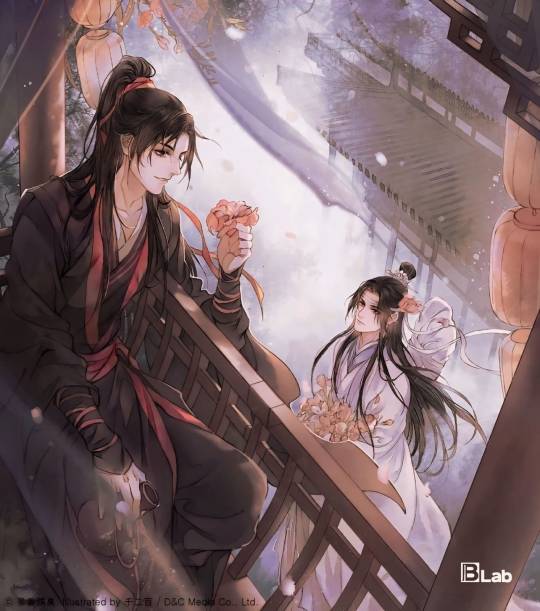
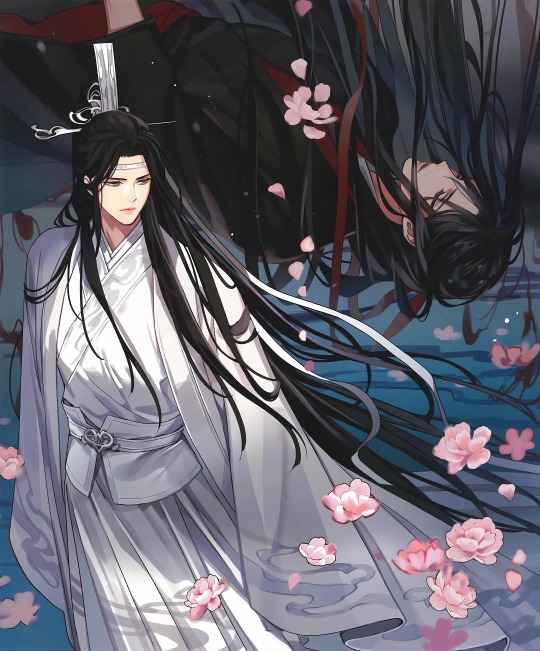
In the series, a white peony cultivar named “Sparks Amidst Snow” is used as the symbol of the Langling Jin Clan. It is said that “by comparing themselves to the king of flowers, they implied they were kings among immortals” (MXTX, v.1, p. 65). This ties in with the peony flower’s symbolic meanings of prosperity, wealth, honour and regalness. Furthermore, pink peonies are often associated with the novel’s central love story between Wei Wuxian and Lan Wangji. During the Siege Hunt at Mount Baifeng, Wei Wuxian throws a pink peony to Lan Wangji amidst the parade. Later, while on a trip to Yunmeng, the latter once again encounters Wei Wuxian who throws him another pink peony. In this audio drama adaptation of this scene, Wei Wuxian asks a ghost woman what the meaning of peony is, and she responds that it means "wishing you would return my feelings" or to part with a heavy heart." Years later, following Wei Wuxian's death and resurrection, he finds a pressed peony flower that Lan Wangji uses as a bookmark. This peony was noted by Wei Wuxian as being “extremely well preserved, [with] the colours still vivid and the veins on its petals so delicately textured that it still looked alive” (MXTX, v. 3, p. 191). Given Lan Wangji's sentimental nature, this peony is undoubtedly one of those given to him by Wei Wuxian. The flower’s association with the pair ties into its symbolic meanings of love, compassion, and happiness.
-> 6) Willow Tree



-> 6.1.) Willow Tree Symbolism:
Willow trees are known as liǔ (柳) in China. They are regarded as a symbol of friendship, long-lasting affection, and "urging someone to stay." Willow trees are also connected with spring, therefore they can represent renewal, resilience, the cyclical cycle of existence and the revival of life after a dormant period in winter. Additionally, the willow tree's supple branches can convey an image of meekness and humility. The willow tree's interwoven branches symbolise the depth of friendship because similarly to how branches connect and support one another, genuine friendship is also based on trust, understanding, and mutual support. The willow tree is also associated with separation from loved ones, prompting feelings of sorrow and longing. Willow branches are commonly utilised in Chinese funeral rites as a symbol of grief and remembrance. Willows, known in Japan as yanagi (柳), represent obedience, independence, and the melancholy of love in hanakotoba. The willow’s symbolism of obedience is derived from how its leaves sway in the wind. In contradiction with this, its symbolic meaning of freedom also stems from how freely its leaves sway in the wind. In Western floriography, willows are associated with both freedom and sadness. Weeping willows in particular represent grief, melancholy, and mourning.
-> 6.2.) Willow Trees in MDZS:


Given its symbolic meanings, willow trees can be associated with Jiang Cheng and Wei Wuxian’s complicated, but strong dynamic. This is supported by Wei Wuxian specially mentioning a willow tree when remising about his youth spent in Lotus Pier with Jiang Cheng—“there was an old willow tree rooted on the bank, with a thick, sturdy trunk that slanted over the water and branches that trailed onto its surface. The boys of Lotus Pier would often walk along the trunk of this particular willow tree to sit and fish from the treetop” (MXTX, v. 3, p. 109). While the duo's bond started as one of trust, support, and mutual understanding, it has distorted into one of melancholy, mourning, and longing. This juxtaposition encompasses all of the willow's connotations across various cultures. The willow’s association with spring, renewal, resilience and revival could be indicative that Jiang Cheng and Wei Wuxian’s bond could be repaired if given time, considering that they never properly reconciled because of Jiang Cheng’s reluctance—“But just as the Wei Wuxian of the past who’d extracted his golden core for Jiang Cheng had been unable to tell him the truth, the Jiang Cheng of the present could no longer bring himself to speak up” (MXTX, v. 5, p. 127).
◣━━━━━━━━━◢✿◣━━━━━━━━━◢
╰┈➤ Part 1
╰┈➤ TGCF Hanakotoba Post Part 1
╰┈➤ Other Hanakotoba Posts
[Please check out part 1 as well! If anyone has any ideas on what anime/anime theme song I should cover next in this series please lmk✿ Also, if you liked this post, check out my other hanakotoba analysis posts... Lastly, if I've gotten any of the kanji, romaji, hanzi or pinyin incorrect, feel free to correct me]
#mdzs#mo dao zu shi#grandmaster of demonic cultivation#the grandmaster of demonic cultivation#mxtx#mxtx mdzs#mo xiang tong xiu#donghua#danmei#anime#anime hanakotoba#hanakotoba#floriography#hanakotoba analysis#mdzs donghua#wei wuxian#wei ying#lan wangji#lan zhan#wangxian#wuji#wei wuxian x lan wangji#wei ying x lan zhan#jin zixuan x jiang yanli#jiang yanli#jiang cheng#jin clan#jiang clan#mdzs wwx#mdzs lwj
53 notes
·
View notes
Text
youtube
Costa is at a magical water garden that he has wanted to visit for years.
Austral Watergardens in Cowan, NSW, sits on 7 acres with views of the Muogamarra nature reserve.
Kevin and Lisa Metelik have been managing the mountain paradise for decades.
Kevin’s grandfather bought the land, set up the water gardens in the 1940s and inspired his daughter to follow in his footsteps; Kevin got the gardening bug from her.
Lisa met and married Kevin and got the bug as well.
Some of the original concrete ponds still exists, with plenty of new ones too, all filled with a range of different water plants. Visitors can choose plants from these stock plants and take them home for their own pond or bowl.
The water is kept clean by finding the right balance of shade and sun, plus native fish to keep down mosquitoes without affecting the frog populations.
Kevin says there are two main groups of water lily: Hardy or European and tropicals.
Hardy or European are the style seen in Monet paintings, with red, pink, yellow and white flowers that sit at water level. They flower earlier, from October to April, and blooms range from miniature to large.
Tropical waterlilies hold their flowers above the water line and are usually fragrant; colours include blues, white, yellow, and pink, and they bloom from December to June in the Sydney area (all year in tropical climates) but may not survive winters in colder areas.
Hardy waterlilies have rhizomes while the tropical ones have bulbs.
Lotus are different again; they are large plants, are revered as sacred in many cultures. The leaves sit above the water and flowers form distinctive seed heads.
Other less obvious but equally useful plants include the native Snakeskin vallisneria, which grows underwater and improves water quality as well as providing habitat for fish and frogs.
Border plants such as jointed twig-rush can tolerate quite deep water.
Red-stemmed thalia gives a tropical look to a pond and is a favourite with frogs.
How to build your own water garden:
A water feature will bring frogs, dragonflies and beauty to a garden, creating a mini oasis. Here are some basic steps to get you started.
Consider the size and depth of a water bowl as well as the material – a lightweight fiberglass or polymer resin makes a large vessel easier to handle. Ceramic bowls may need to be sealed.
The minimum depth is 30cm for water plants; deeper is better. Lisa tries to create three levels in a pond:
* a submerged aquatic plant
* a shallow-water creeper group to grow on the edges
* a tall marginal plant for height
Add in water lilies for flowers and floating leaves; if you can fit two plants, choose one hardy and one tropical species for a longer flowering display.
Put river sand or gravel on top of the soil mix in the pot to avoid muddying the water.
Aim to cover about half to two-third of the water surface with plants.
Add native, tadpole-friendly fish to keep mosquitoes at bay
Filmed on Dharug Country in Cowan, NSW
Featured plants:
Waterlily ‘Escarboucle’ (Nymphaea cv.)
Waterlily ‘Marliacea albida’ (Nymphaea cv.)
Waterlily ‘Blue Triumph’ (Nymphaea cv.)
Sacred Lotus (Nelumbo nucifera)
Snakeskin vallisneria (Vallisneria nana)
Jointed twig-rush (Machaerina articulata syn. Baumea articulata )
* Red-stemmed thalia (Thalia geniculata)
Water milfoil (Myriophyllum ‘Dragonfly’)
* Taro (Colocasia esculenta cv.)
Waterlily ‘Colorado’ (Nymphaea cv.)
Waterlily ‘Green Smoke’ (Nymphaea cv.)
Firetail gudgeon (Hypseleotris galii)
* Always check species before planting: they may be environmental weeds in your area.
#gardening australia#solarpunk#australia#garden#gardening#water garden#ponds#pond#water lily#lotus#plants#Youtube
6 notes
·
View notes
Text







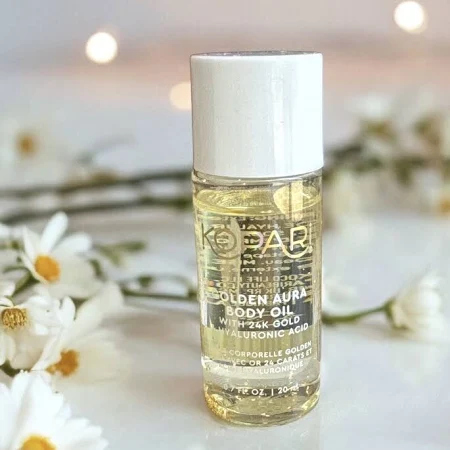

Kopari Beauty Golden Aura Body Oil With 24k Gold & Hyaluronic Acid .7 fl oz NEW. What it is: An oil that allows you to experience deep hydration and instant moisturization. Who it's for: Ideal for all skin types. What it does: The intensely rich yet fast-absorbing formula features hyaluronic acid, 24-karat gold and antioxidants so skin is left soft and smooth with an irresistible glow. The oil is fast-absorbing yet nongreasy and features a warm floral scent with notes of toasted sugar, jasmine and sweet creamy musk. How to use: Apply generously and evenly after bathing while skin is damp. Can also be used on dry skin. Natural Beauty & Wellness products are free of sulfates, phthalates, parabens, petrochemicals, mineral oil, silicone and talc; also free of PEGs Cruelty-free Vegan Made in the USA Ingredients Helianthus Annuus Seed Oil, C12-15 Alkyl Benzoate, Butyrospermum Parkii Oil, Parfum, Caprylic/Capric Triglyceride, Cocos Nucifera Oil, Tocopherol, Glycine Soja Oil, Squalane, Ricinus Communis Seed Oil, Gold, Sodium Hyaluronate, Hydrogenated Castor Oil, Benzyl Alcohol, Coumarin, Hexyl Cinnamal, CI 77820, CI 77400 Ingredients are subject to change at the manufacturer's discretion. For the most complete and up-to-date list of ingredients, refer to the product packaging FREE SHIPPING. VOLUME PRICING. SEE HOMEPAGE FOR COUPONS. THANK YOU!
DAWNETTSEMPORIUM, #BEAUTIFULMERMAIDQUEEN, #SHAUNALYNNSFOOD.
4 notes
·
View notes
Text
Mafia AU Sonas (Info Dump)
Warnings: Violence, death, mafia, etc.
Nucifera - Mafiafell H
Personality: She is cruel and vicious. She is only kind to her loved ones and often displays a startling level of coldness and harshness against persons she despises. She is strict, yet when it comes to her loved ones, she is often a softie. She enjoys writing and reading, and she takes her work as a mafia boss extremely seriously and is not afraid to cope with it. She isn't afraid to get her hands dirty, and she aggressively thwarts rival mafias as if it were a game. She excels at what she does. She goes for the throat and doesn't hesitate when it comes down to it.
Appearance: She has curly long brown hair. She either wears glasses or has contacts. She is chubby. She has two scars on her right eye. She's 5'1".

Rowana - Mafiafell Skelesona
Personality: She is a strong and courageous woman. She is harsh and ruthless when she goes for the throat. Despite this, she has a friendly and lovely attitude. She's direct and honest. She lacks self-control and will quarrel with someone. She emanates self-assurance and strength. She makes every effort to learn how to be a good leader. She will go to tremendous lengths to defend those she loves. She is very sympathetic, yet she also knows how to deliver direct advice. She is also stern and severe. Her self-preservation instincts are superb. She is capable of and will attack anybody she dislikes.
Appearance: She has reddish-purple eyelids. She’s 5'4" and growing. Her canines are sharper than the rest of her mouth. She has scars all over her bones. She has a small scar on her eye. She doesn’t need glasses in comparison to her counterparts.

Bellis - Mafiaswap H
Personality: She is a trustworthy and caring woman. She is a natural leader. She is very personable and tries hard not to offend people, yet she may be a little blunt. She has good self-control and isn't afraid to fight. Her writing is done with the help of friends. She is a highly creative and open-minded individual who tackles everything they do with care and uniqueness. She is a social butterfly who does not shy away from meeting new people. She is brilliant and creative, and she appears to be immersed in her thoughts and daydreams all the time.
Appearance: She has hazel eyes. She has shaved one side long curly brown hair. She wears glasses or has contacts. She is thinner than her various counterparts. She's 5'1". She has prominent scars on her shoulders, back, and torso. She has a small scar on her eye.

Bellum - Mafiaswap Skelesona
Personality: She is a well-known and prominent figure. She is exceedingly self-assured and exudes charisma for days. She is brave and astute, yet she is also compassionate and patient. She is a social butterfly with several friends. She is an extremely powerful magician who is arrogant about her powers. She isn't scared to express it. She has shown a tendency to fight those who anger her. She is a singer, painter, and photographer. She is also a flirtatious person who has had countless dates and relationships. She is also well-dressed and has a sense of style.
Appearance: She's a skeleton monster! She has purple eyes and purple magic. She is 5'1". Her ecto is purple.

-------
@kioko-noodles / @kiokodoodles @miscneilleaneous @und3rwat3r-a5tr0naut @hearty-dose-of-ranch @didderd @underfell-crystal @the1920sisntaphasemom @rainbowut
#info dump#info#mafiaswap#mafiafell#mafiatale#mafiaswap skelesona#mafiaswap h#mafiafell skelesona#mafiafell h#lots of info#girlies
5 notes
·
View notes
Text

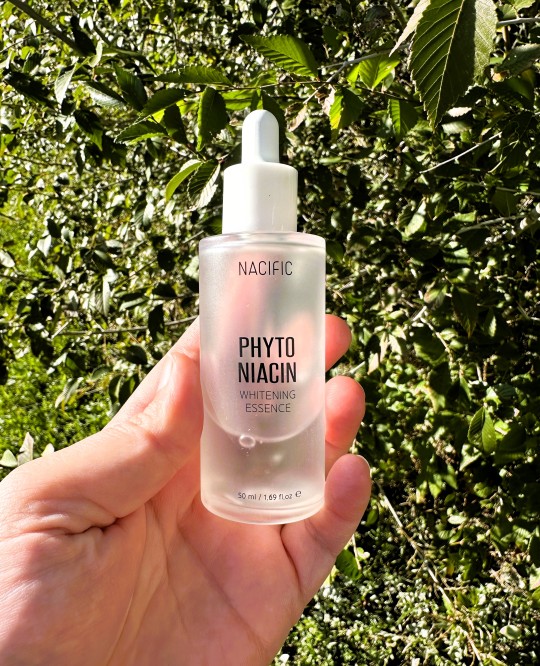
Review of NACIFIC's Phyto Niacin Whitening Essence
NACIFIC is a Korean brand that uses only the best natural ingredients. Their Phyto Niacin Whitening Essence is designed to moisturize the skin and reduce pigmentation, it's formulated to brighten dull skin for a flawless complexion. Key ingredients include: 5% of niacinamide (whitening, lightening, anti-aging, rejuvenating, anti-wrinkle), bamboo extract (soothing, adds vitality, anti-inflammatory, removes dry skin, antioxidant, healing, hydrating), lemon fruit extract (skin clearing, brightening, lightening, anti-inflammatory, improves skin health), sodium hyaluronate (anti-aging, anti-wrinkle, hydrating, moisturizing, healing), white mulberry bark extract (antioxidant, anti-irritation, evens skin tone, whitening), edelweiss extract (anti-aging, anti-inflammatory, antibacterial, antioxidant, calming), and wormwood extract (healing, antibacterial, anti-fungal, skin protective, soothing, anti-inflammatory, anti-redness, adds radiance to the skin). This essence retails for between $12-18 USD, you can get it here for $12.80 + shipping.
Ingredients
Bambusa Vulgaris (Bamboo) Extract, Butylene Glycol, Glycerin, Niacinamide (5%), 1,2-Hexanediol, Pentylene Glycol, Caprylyl Glycol, Acrylates/C10-30 Alkyl Acrylate Crosspolymer, Sodium Hyaluronate, Disodium EDTA, Water, Potassium Hydroxide, Rosa Canina (Rosehip) Fruit Extract, Alcohol, Morus Alba (White Mulberry) Bark Extract, Leontopodium Alpinum (Edelweiss) Extract, Ethyl Ascorbyl Ether, Gentiana Lutea Root Extract, Artemisia Absinthium (Wormwood) Extract, Arnica Montana Flower Extract, Achillea Millefolium (Yarrow) Extract, Propylene Glycol, Citric Acid, Citrus Limon (Lemon) Fruit Extract, Potassium Sorbate, Nelumbo Nucifera (Sacred Lotus) Extract, Sodium Benzoate
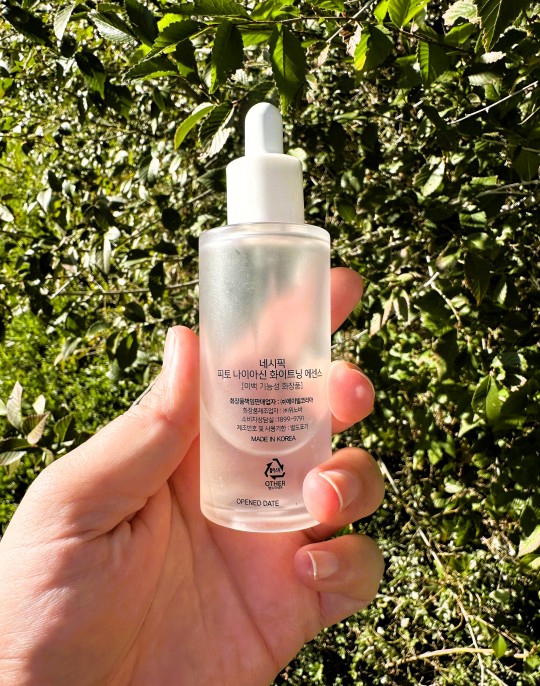
This essence contains 50 ml (1.69 oz) and is fragrance-free. It comes in a sturdy plastic bottle with a dropper.
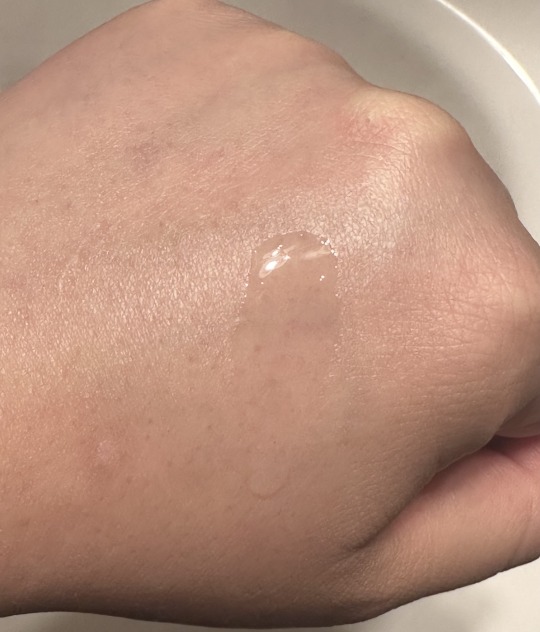
The essence is very watery and clear.

It's very lightweight and hydrating.
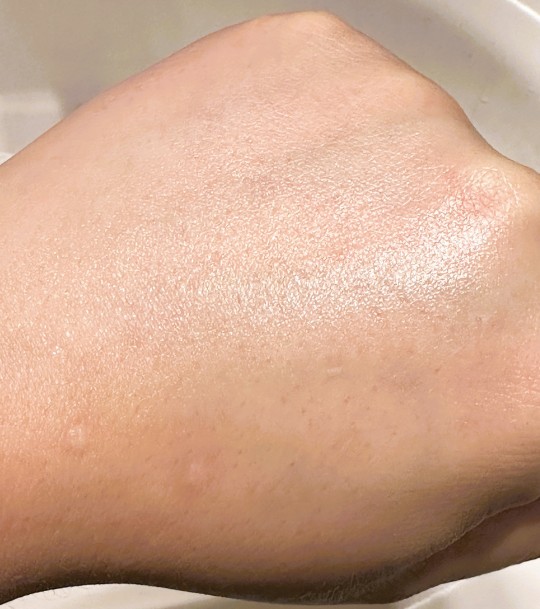
It leaves skin looking more dewy and brighter.
Recommended use is after washing your face and toning, lightly shake the essence and apply it with your fingertips along your skin texture. Cover your face with your palms and press down for better absorption. After using, this essence is really impressive to me. It doesn't have any fragrance, but it does contain a couple of irritants, this also might not work with very very sensitive skin as it has active niacinamide and lemon extract, I do notice that it can burn if you have any broken skin or skin that's been picked at. The essence spreads very well and helps to plump and hydrate skin and you will notice a subtle brightening of the skin as well after each use. It helps to tone redness and even skin tone, it helps to refresh dull and dry skin. The ingredients are very hydrating as well as nourishing to the skin. The texture of the essence is really watery and lightweight, so this would be great for any skin type. It's also not sticky or tacky at all. I feel like this is actually pretty gentle despite having some irritants and actives so I'd recommend this to pretty much anyone unless you have issues with niacinamide.
What I like: this essence is really lightweight, it absorbs quickly and layers perfectly well under other skincare. It's almost instantly subtly brightening and it's very hydrating without being tacky or sticky. The ingredients are really good and this is relatively gentle and would probably suit most skin types. What I don't like: this does sting on open wounds or cuts and it does have some irritants.
Pros:
Hydrating
Nourishing
Refreshing
Brightening
Tones redness
Nice ingredients
Pretty gentle
Fragrance-free
Cons:
Can sting on open wounds
Can be irritating
Would I buy again?
Yes
Rating: 9/10
5 notes
·
View notes
Text
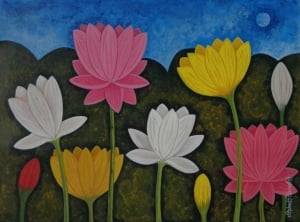


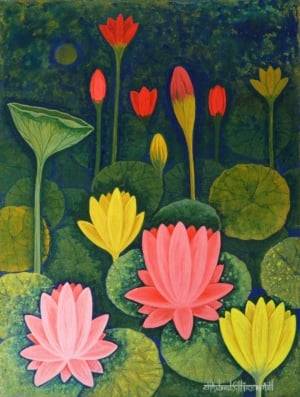


Lotus paintings by CHANDRU HIREMATH, Bangalore, India.
The lotus flower means purity, rebirth, and strength. It rises from the mud without stain, it returns to the murky water each evening and opens its blooms at the break of day exhibiting resilience and rebirth. Still another lotus flower meaning is transcendence: the lotus represents the transcending of man’s spirit over worldly matter as its blooms come from the underworld into the light.
The lotus is referenced in Vedic texts dating back to 1400 BC. Hindu deities are frequently depicted with lotus flowers (or are otherwise associated with the lotus flower in some way). As the national flower of India, the lotus has long served as a symbol within the country’s arts, culture, philosophy, and religions.
Lotus flowers fall under the genus Nelumbo, which contains just two living species of aquatic plants, both of them lotuses. These are:
Nelumbo nucifera—This is the better-known species of lotus. It's native to much of Asia, including India, China and Vietnam, and can be found in parts of Australia, as well. This particular species is often called the "Sacred Lotus", because it's the species that has been revered in Buddhism and Hinduism religious traditions for centuries.
Nelumbo lutea—The second living lotus species is Nelumbo lutea, which is native to North and Central America. This species is not as well known as Nelumbo nucifera, and doesn't have the same religious significance. It's also sometimes called the "yellow lotus", owing to its yellow petals, and the "American lotus", for obvious reasons.
Despite their delicate appearance, lotuses are actually incredibly hardy plants. Their seeds can survive underground for hundreds, if not thousands, of years. That's how the lotus flower survived the last Ice Age.
Lotus leaves are superhydrophobic, meaning they repel water.
As water droplets fall upon the leaves, they gather up dirt and other foreign materials as they roll off the surface, allowing the leaves to self-clean.
This behaviour in nature is termed the "lotus effect", and it's something scientists and engineers have begun trying to replicate to create more water-repellent fabrics.
All parts of the lotus plant are edible.
6 notes
·
View notes
Text

Blue Venus
Watercolor On Artboard
2022, 10"x 8"
Lotus Blossoms, Nelumbo nucifera
Turquoise and Kyanite
Private Collection
#art#nature#flowers#plants#artwork#painting#minimalism#watercolor#artists on tumblr#floral#lotus#water plants#botany#garden#turquoise#lotus flowers#artist#original art#blue#flora#artists#lotus blossoms#nelumbo nucifera#water#crystal witch#witchblr#water witch#kyanite
90 notes
·
View notes
Text
Best Hair Oil for Dry and Frizzy Hair

Finding the best hair oil for dry and frizzy hair can feel like searching for a magic potion. But the right blend of ingredients can transform your hair from brittle and unruly to soft, manageable, and full of life. Here, we explore a range of nourishing oils that cater to dry and frizzy hair, helping you reclaim your hair’s natural beauty.
Why Dry and Frizzy Hair Needs Special Care
Dry and frizzy hair lacks moisture, making it prone to breakage and split ends. Environmental stressors like pollution, UV rays, and dust, coupled with heat styling and chemical treatments, can worsen the situation. The solution? A hair oil packed with hydrating and protective ingredients to replenish moisture and repair damage.
Ingredients That Make the Best Hair Oil
A great hair oil isn’t just about one hero ingredient—it’s the synergy of multiple natural extracts and oils that work together to nourish and protect your hair. Let’s dive into some superstar ingredients you should look for in the best hair oil:
1. Amla Extract (Emblica Officinalis Fruit Extract)
Amla is a multitasking marvel for hair care. Its antibacterial and antimicrobial properties soothe a dry, flaky scalp while shielding hair from environmental stressors. Amla is also widely believed to prevent hair loss and promote new hair growth, making it a true “beautitasker.”
2. Coconut Oil (Cocos Nucifera Oil)
Coconut oil’s unique blend of fatty acids and vitamins penetrates deeply into the hair shaft, thanks to its lauric acid content. This helps lock in long-lasting moisture, repair damage, and reduce protein loss, leaving your hair soft and shiny.
3. Apricot Kernel Oil (Prunus Armeniaca Kernel Oil)
Rich in Omega-9 essential acids, apricot kernel oil provides deep hydration and keeps your hair supple. Its humectant properties draw in moisture from the air, ensuring each strand stays hydrated throughout the day. It’s a perfect addition for taming frizz.
4. Orange Peel Oil (Citrus Aurantium Dulcis Peel Oil)
Packed with antioxidants, orange peel oil conditions the hair naturally and helps reduce dandruff. It balances excess scalp oil, making it ideal for maintaining a healthy scalp environment. Plus, its refreshing citrus aroma adds a sensorial treat to your hair care routine.
5. Kalonji Oil (Nigella Sativa Seed Oil)
Kalonji oil, derived from black seed, is rich in antibacterial and antifungal properties that help resolve scalp issues such as eczema and psoriasis. It also contains thymoquinone, an antihistamine known to promote hair growth and strengthen the hair shaft.
Squigs Beauty’s Secret to Beautiful Hair
If you’re looking for a hair oil that combines the benefits of these powerhouse ingredients, Squigs Beauty offers a fantastic option. Their formulations include natural oils and extracts that are thoughtfully curated to tackle dryness, frizz, and scalp issues, giving your hair the nourishment it deserves. It’s not just about treating your hair; it’s about pampering it.
Additional Ingredients to Look For
The best hair oil for dry and frizzy hair should also include complementary ingredients that enhance its effectiveness. For instance:
Sunflower Seed Oil (Helianthus Annuus Seed Oil): Known for its lightweight texture, this oil deeply nourishes without weighing your hair down.
Castor Seed Oil (Ricinus Communis Seed Oil): A trusted ally for hair growth, castor oil strengthens the roots and seals moisture.
Sesame Seed Oil (Sesamum Indicum Seed Oil): Packed with antioxidants, it protects your hair from environmental stressors and provides a natural shine.
Grapefruit Peel Oil (Citrus Paradisi Peel Oil): Adds a touch of freshness while balancing scalp oils.
Olive Fruit Oil (Olea Europaea Fruit Oil): Offers deep hydration and helps repair damaged hair.
How to Use Hair Oil Effectively
To get the most out of your hair oil, follow these simple steps:
Apply Generously: Warm a small amount of oil in your hands and apply it evenly from the scalp to the ends of your hair.
Massage the Scalp: Spend a few minutes massaging your scalp to improve blood circulation and allow the oil to penetrate deeper.
Leave It On: Let the oil work its magic for at least 30 minutes or, for best results, overnight.
Wash Off Gently: Use a mild shampoo to rinse out the oil without stripping away its benefits.
Embrace Healthier Hair
Dry and frizzy hair doesn’t have to be a lifelong struggle. By choosing the best hair oil with nourishing ingredients like amla, coconut, apricot kernel, and kalonji oils, you can restore moisture, repair damage, and enjoy smooth, shiny hair. Squigs Beauty’s carefully crafted products are a wonderful place to start—your hair will thank you!
0 notes
Text

ig - afternoondreams
#kelli soukup#nature#photography#botany#botanical#summer#plants#lotus#august#september#nelumbo nucifera#nelumbo nucifera lotus flower#flowers#floral#peaceful#calming#flora#water#dreamy#art#aesthetic#magical#cinematic#photographers#nature photography#lotus flower#lotus flowers
53 notes
·
View notes
Text
Tiān Guān Cì Fú Hanakotoba Analysis Part 2
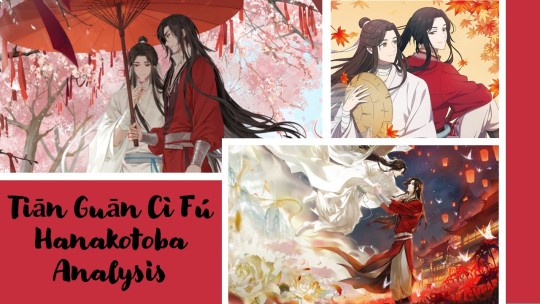
◤━━━━━━━━━◥𐀔◤━━━━━━━━━◥
-> 4) Lotus/Water Lily

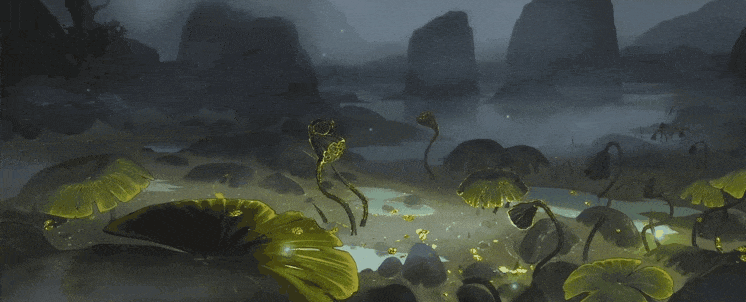
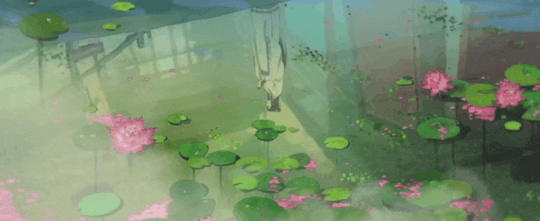
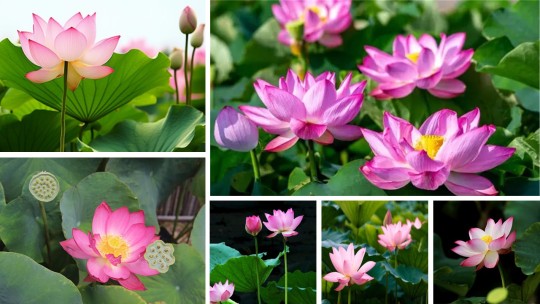
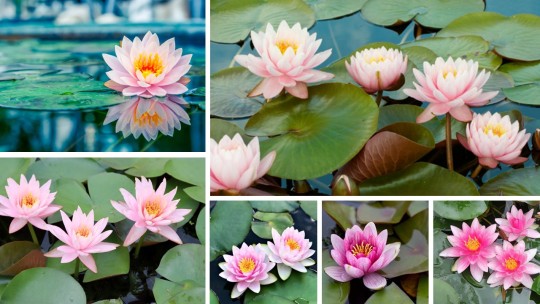
Despite having a few distinguishing characteristics, lotuses (Nelumbo nucifera) and water lilies (Nymphaea) are frequently mistaken for one another. As a result of this, their symbolic meanings frequently overlap to the point where they have the same connotations across certain cultures. Thus, for the duration of this post, I shall use both names interchangeably. In China, lotuses are known as lián huā (蓮花) or hé huā (荷花) while water lilies are known as shuìlián (睡莲) and héhuā (荷花). They are renowned as the gentleman's flower since they grow upwards pure and unstained from the mud. As a result of how it grows, this flower is associated with endurance, elegance, resilience, triumph over adversity and ultimate purity of mind and heart in China. The lotus is considered a sacred flower, embodying the essence of divine beauty and grace. It is also a symbol of moral integrity, emphasising the importance of maintaining inner purity and virtuous behaviour in the face of worldly temptations. In China, part of the lotus flower’s Chinese name “l蓮” (lián) is homophonous with the words “聯” (lián) meaning “to bind/connect as in marriage”; “戀” (liàn) meaning to love; and “廉” (lián) meaning modesty. This has resulted in the lotus flower symbolizing love, marriage and unions in Chinese culture. The lotus is thus a common motif in poetry, from the Tang and Song dynasties to contemporary works, and it is used to express love, convey feelings, and reflect on the state of humanity. A single stalk bearing two lotus flowers symbolises the yearning for harmony and a shared heart. This was derived from the fact that the “荷” (hé) in the lotus flower’s other Chinese name also means “union” and is homophonous with the word “和” (hé) meaning uninterrupted or one after another. In addition to this, a lotus bloom complete with a leaf and bud represents a complete union. Water lilies are often used in bridal bouquets because they are considered a lucky charm and symbol of 100 years of love in China. The word “l蓮” (lián) also sounds similar to “連續” (liánxù) which means continuous. This conveys the idea of constant growth and spiritual progress thus making the lotus a symbol of the continuous pursuit of knowledge, wisdom, and enlightenment. Lotus flowers symbolize purity, wisdom, peace, perfection, humility, enlightenment and rebirth in various Asian cultures because of their strong connection to Buddhism. The lotus is commonly used as a metaphor for the path to enlightenment in Buddhist literature. In the same way, as lotuses arise from the murky depths of ponds and lakes, pure and uncontaminated by the pollutants of their surroundings, so too are humans capable of rising above the obstacles and temptations of the outside world to achieve enlightenment and spiritual purity. The lotus is compared to the pure soul in South Asian Ismaili literature. There is a poem that highlights the beauty of the lotus, noting how its delicate white petals remain pure and attractive despite their murky surroundings. Similarly, a pure soul is both part of and not of this world, much like the lotus's surroundings. The lotus has deep symbolic meaning in Taoism, such as representing peace, balance, and the interaction of the natural and human worlds. It is a strong metaphor for the "interconnectedness of all things and the inherent harmony within the universe". The serene beauty of the lotus flower and its adaptability to many environments are representative of the Taoist concept of living in harmony with the natural order of things, flowing with life's rhythms, and maintaining balance in the face of change. In Taoist philosophy, the lotus is also connected to transcendence and immortality. Its enduring cycle of life, death, and rebirth is symbolised by its capacity to regenerate and blossom year after year in spite of the changing seasons. The lotus is a representation of transcendence and spiritual development that guides individuals towards a state of inner immortality and connection with the divine.
In Japan, lotuses are called ren (蓮) or hasu (はす) while water lilies are called suiren (睡蓮). In hanakotoba, lotuses symbolise eloquence, detached love, sacredness and a pure heart. They are also associated with rebirth, purity, transformation, renewal, spiritual enlightenment and resurrection as well as beauty, grace and perfection. In hanakotoba, water lilies symbolise a pure heart, faith and trust. In Western floriography, water lilies symbolize purity of the heart, virtue, innocence, achieving great things, beauty rising from humble beginnings and bringing together separate things. Pink waterlilies in particular are often associated with feelings of admiration. Since its scientific name was derived from the Greek nymph, water lilies while a symbol of beauty also has a dangerous side in addition to being a symbol of unity and balance. Lotuses can also symbolize estranged love as well as eloquence in floriography.
Despite a certain someone’s trials and attempts to corrupt Xie Lian in order to mould him into a perfect successor, the latter remained firm in his beliefs—"I just won’t change! Even if it’s painful I won’t change, Eve if I die, I won’t change, I will never change!” (MXTX, p. 1937). This ties in with the lotus flower’s symbolism of “rising above obstacles and temptations of the world to reach enlightenment and spiritual purity”, “triumph over adversity” and “maintaining balance in face of change” as well as “ultimate purity of mind and heart”. The lotus flower’s symbolic meanings of humility, virtue, resilience and constant growth complement Xie Lian’s character after his third ascension while its meanings of perfection, divine beauty, grace, and purity complement his character before and during his first ascension. The lotus flower’s symbolic meanings of perfection, virtue, divine beauty, grace, and purity complement his character before and during his first ascension while its meanings of humility, wisdom, resilience and constant growth complement Xie Lian’s character after his third ascension. The lotus is a highly revered flower in both Taoism and Buddhism, and both have served as inspiration for the basis of Tiān Guān Cì Fú’s complex setting and lore. The lotus flower’s symbol meanings of “transcendence and immortality”, “divine beauty and grace”, “unity and balance”, “the cycle of life, death and rebirth” as well as “rising above obstacles and temptations of the world to reach enlightenment and spiritual purity” are all recurring motifs in Tiān Guān Cì Fú. Additionally, the lotus’ symbolism of longstanding love and feelings of admiration tie into Hua Cheng and Xie Lian’s relationship. A single stem bearing two lotus flowers denotes a desire for harmony and a shared heart. To share someone’s heart is to completely understand, accept and support them. Xie Lian professes his desire to understand Hua Cheng—"I want to understand your everything" (MXTX, p. 943)—while Hua Cheng states at the end of the book, "I understand your everything. Your courage, your despair, your kindness, your pain, your resentment, your hate, your intelligence, your foolishness” (MXTX, p. 1953). Xie Lian is completely enamoured by Hua Cheng and wants to be someone he can confide in and rely on. While Hua Cheng not only adores Xie Lian but fully understands him and accepts every part of him. As a heavenly official and a supreme ghost king respectively, Xie Lian and Hua Cheng's union brings together the heavenly and ghost realms—which embodies the lotus' symbolism of unity, balance and bringing together separate things. Throughout various cultures, the water lilies and lotuses repeatedly symbolize gracefully overcoming adversity as well as embodying the essence of divine beauty and grace; because they grow pure and unstained by the mud in which they grow. This sentiment is reminiscent of one of the most famous quotes in Tiān Guān Cì Fú which was said by both Xie Lian and Hua Cheng—“The one standing in infinite glory is you; the one fallen from grace is also you. What matters is ‘you’ and not the state of you” (MXTX, p. 943 & 1438 & 1930).
-> 5) Autumn Ginkgo & Maple Trees
In the scene wherein Xie Lian meets “San Lang” for the first time, there are Ginkgo (Ginkgo biloba) and Maple trees (Acer) present in the background. Their vibrantly coloured leaves cascade onto the pair as they converse, creating a picturesquely autumnal setting. A ginkgo tree is also present in the scene where Xie Lian speaks to other heavenly officials via the communication array while maple trees are featured in many pieces of official artwork for the donghua.
5.1) Ginkgo
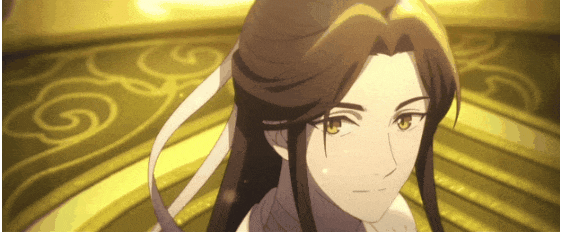
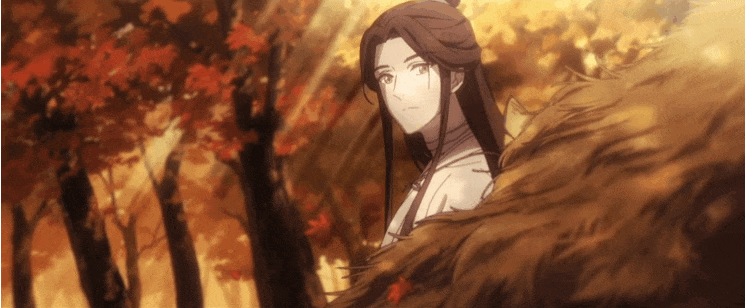

Ginkgo trees are known as yínxìng (銀杏 ) in China and are the country’s national tree. In Chinese culture, ginkgo trees are highly symbolic of longevity, endurance, resiliency, and hope. The ginkgo's symbolic meaning is said to be derived from the tree’s ability to survive under the harshest conditions as well as its long lifespan. When displayed as a single tree, it stands for strength and solitude. In Japan, ginkgo trees are called ginkyo (銀杏) and symbolise magnificence, longevity, requiem, strength, hope and peace in hanakotoba. In Western floriography, ginkgo trees symbolise solemnity, longevity and requiem. The beauty and symbolism of the ginkgo tree are valued by many European cultures, who associate it with power, resilience, human progress, enlightenment, and memory enhancement. The ginkgo tree also represents renewal as shows off a magnificent colour display each autumn as it sheds its leaves to sprout new ones. Even if he denies it—"Don’t think someone overly perfect... If it’s just watching a shadow from afar and never having to interact, then whatever. But once acquainted and grown close, you will find that this person was not what you had imagined; maybe the complete opposite. When that happens, you will be completely disappointed” (MXTX, p. 445)—Xie Lian embodies the qualities of hope, peace, strength, and resiliency. Hua Cheng, on the other hand, sees Xie Lian as the embodiment of hope—"You never know. I don't care if anyone else is disappointed. But to some, the very existence of a certain person in this world is in itself, hope” (MXTX, p. 445). Which encapsulates the symbolic meanings of the Ginkgo tree: strength, hope, resilience, peace, and perseverance.
5.2) Maple


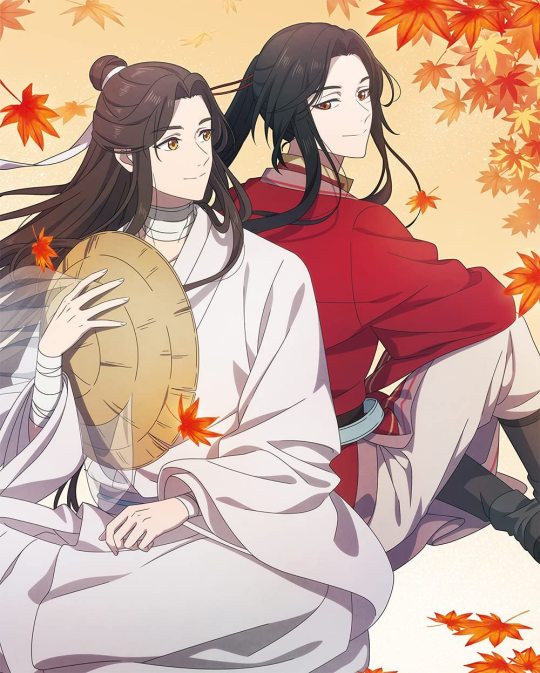
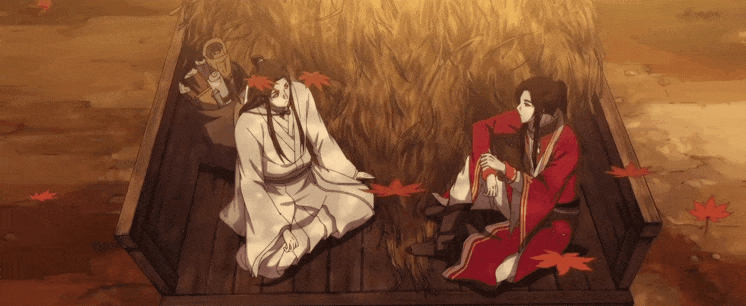
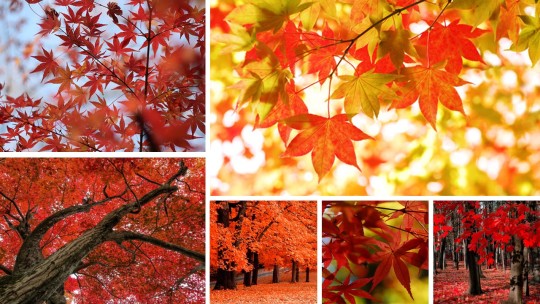
“Looking up they were traversing through a maple grove, a sea of flaming red in a field of green. The rustic charm of the mountainous countryside, with fresh grass that refreshed the mind, was extremely intoxicating. But, Xie Lian could not help but give a slight start. A long time ago, in his youth, when he cultivated at the Royal Holy Pavilion, the entire mountain of maple was like this: shimmering like gold, intense like fire. The unforgettable sight before him now inevitably took him on a trip down memory lane” (MXTX, p. 117). Maple trees are known as fēngshù (楓樹) in China and primarily represent the passage of time and seasonal change. Furthermore, maple trees have traditionally been associated with abundance and positive energy in Chinese Feng Shui. These trees are thought to denote growth and prosperity. This is partly because red is considered an auspicious colour in China and is thought to bring good luck and happiness. Maple leaves and bark are also frequently used as materials in Taoist spells for drawing out courage, wealth and luck as well as for healing and attracting love. The maple tree is also a symbol of enduring love since it is frequently associated with loyalty and durability. Hence, maple leaves are connected to marriage and love in China. In Japan, maple trees are known as kaede (楓) and symbolize precious memories, restraint and beautiful change in hanakotoba. In addition to this, they also symbolize endurance, strength, resilience, transformation and change. The reason why maple trees are associated with change and transformation is because their leaves change colour with the seasons, morphing from green to yellow, orange, and red. This vibrant range of colors also represents the passing of the seasons, the changing nature of life as well as the beauty and fragility of life. In Japanese culture, the maple tree's five-lobed leaf is a representation of wealth and good fortune. Throughout various Asian cultures, maple trees are associated with persistence and stability, expression and passion, power and regality, endurance and strength as well as determination and resilience. In Western floriography, maple trees are associated with peace, serenity, reservedness, unity, humility, strength, endurance, balance, wisdom, and promise as well as seasonal change and new beginnings. The maple tree has also been utilised as a symbol of passion and desire in literature and art. Its vivid, crimson autumnal leaves represent the intensity of love, while its sturdy roots represent the deep bond between two individuals. While the tree's ability to endure adverse weather represents the tenacity and endurance required in romantic partnerships. Maple trees have been used as an enduring symbol of the transformational power of love in several literary and artistic works. Although roses and doves are more commonly linked with love, maple trees perfectly encapsulate the intense emotion and raw intensity of love. Red maple trees are one of Tiān Guān Cì Fú’s signature motifs because of their use during the scene where Xie Lian meets San Lang—“The cart was driving through the forest of flaming red maples, where maple leaves danced their way to the ground. A leaf playfully landed on the shoulder of the youth, and he blew it off softly, then looked up at Xie Lian, speaking with a shadow of a smile” (MXTX, p. 119). As a result, the use of maple trees in this scene greatly contributes to the romantic atmosphere. Hua Cheng's tremendous devotion to Xie Lian is foreshadowed by the maple tree's connotation of passionate, enduring love and devotion. Considering red is Hua Cheng's signature colour, having Xie Lian surrounded by a veritable sea of red sets the intimate cosy ambience needed for this scene.
-> 6) Red Spider Lily
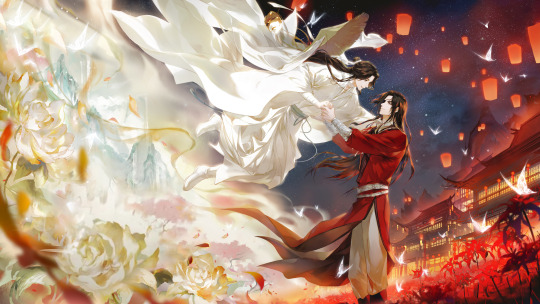
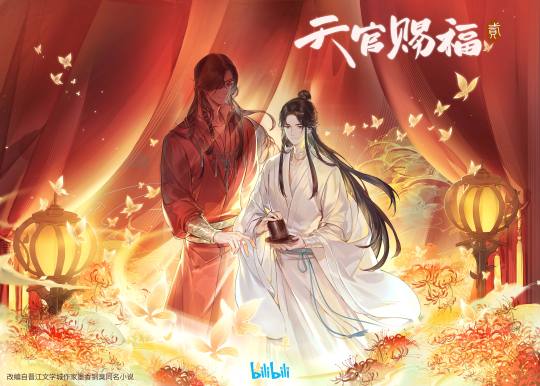
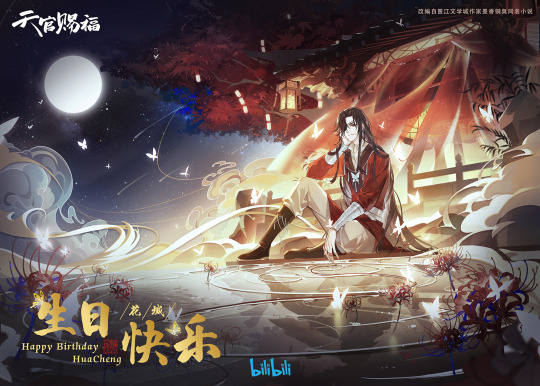
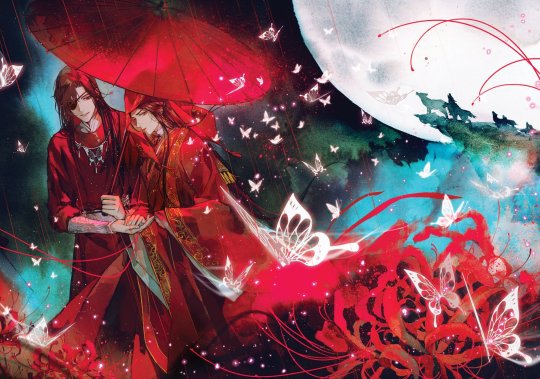
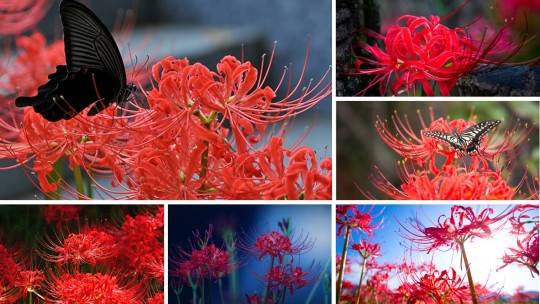
The red spider lily (Lycoris radiata) is known as mànzhūshāhuá (曼珠沙華) or the bǐ'ànhuā (彼岸花) in China and is a symbol of autumn. The flower is also regarded as a symbol of both death and rebirth. Red spider lilies are described as flowers that grow in hell in the Lotus Sutra. As a result of this, certain Buddhist traditions in China and Japan believe that these flowers aid spirits in crossing from the afterlife into reincarnation. The red spider lily also represents beauty because of its vivid, vibrant red blossoms, which give a sense of elegance. In Chinese culture, the red spider lily has a long history and is commonly associated with death and funerals. It is considered bad luck in some parts of China to keep this plant in your home since it is thought to attract ghosts. The flower's sad symbolism for loss and parting is based on an ancient Chinese legend about two elves, Saka and Manju, who were the guardians of leaves and flowers, respectively. They could never meet, however, because the red spider lily never sprouts flowers and leaves at the same time. They both yearned to meet one another, and they violated the gods in order to do so. The gods punished them harshly for this and separated them for eternity. The flower is still associated with loss, both of loved ones and of memories. In Japan, these flowers are known as higanbana (彼岸花) which means autumn equinox flower. They represent sad memories, resignation, independence, lost memory, abandonment, passion and those who are never to meet again in Japanese hanakotoba. The red spider lily is also associated with death, goodbyes, rebirth and the far shore (land of the dead). The red spider lily's symbolic meaning of farewells and rebirth is embodied in classic Japanese artworks depicting mythological situations, where they are referred to as the "flowers of heaven.“ In Japan, there is a strong correlation between the Buddhist and Shinto religions and red spider lilies. These striking flowers are thought to represent rebirth and the transience of life. They are also believed to guide the deceased's spirits transition to the afterlife. They are frequently observed blossoming next to cemeteries or other holy locations. They are also thought to have protective properties that shield against negative energy and evil spirits. Red spider lilies are also thought to symbolise the boundary between life and death in Japanese culture. This is because its flowers bloom during autumnal equinox when Japanese Buddhists believe that deceased people's spirits return to the near shore (the world of the living). Some legends claim that when an individual crosses paths with someone they will never see again, red spider lilies blossom alongside their path. These legends are partly responsible for the flower's affinity with final goodbyes, in addition to its association with death and the hereafter. Despite their frequent association with death and parting, red spider lilies are also admired for their beauty and resilience. They can survive in a range of challenging environments, including rocky and riverside locations, and their vivid red hue helps them stand out against the surrounding scenery. As a result of this, these flowers can also be seen as a symbol of strength and perseverance in the face of adversity.
Red Spider Lilies greatly complement Hua Cheng as only only are they his signature colour but are also associated with death, rebirth, longing, parting, loss and passion which are all traits associated with him. Hua Cheng has effectively died three times and has come back three times which ties into the flower’s association with the transience of life, death and rebirth. Red spider lilies are also seen as a symbol of passion, strength and perseverance in the face of adversity which fits Hua Cheng’s character. In some official artwork such as the one shown above, red spider lilies are associated with Ghost City. This is fitting considering the red spider lilies symbolise the boundary between life and death whereas Ghost City is said to be “the most prosperous place within the ghost realm, situated right at the crossroads of the mortal and ghost realms” (MXTX, p. 287).
◣━━━━━━━━━◢𐀔◣━━━━━━━━━◢

╰┈➤ Part 1 ✿
╰┈➤ Anime Hanakotoba Posts Directory
[Forgive me if I missed anything; I attempted to include everything featured in the donghua, novel and official artwork. There was a lot I wanted to say, but I could not articulate it all as eloquently as I wanted to… I wanted to go all out for this while also keeping it as brief as possible… So, forgive me if this is just tons of gibberish. I always find that I can say and write a lot about the things I like but always find myself inadequate when speaking and writing about the things I truly love. Hopefully, I did this masterpiece justice.
If you liked this post, check out my other hanakotoba analysis posts... Also, if I've gotten any of the kanji, romaji, hanzi or pinyin incorrect, feel free to correct me]
#tgcf#tian guan ci fu#mxtx#mxtx tgcf#mo xiang tong xiu#donghua#danmei#anime#anime hanakotoba#hanakotoba#floriography#hanakotoba analysis#tgcf donghua#tgcf season 2#tgcf s1#tgcf s2#heaven official's blessing#hualian#hua cheng#xie lian#san lang#sanlian#hua cheng x xie lian#hua cheng/xie lian#huaxie#manhua
83 notes
·
View notes
Text
Kumkumadi Face Moisturizer For Everyday Soft Skin — Pnkbeauty

Ingredient :-
Saffron extract ( Kumkumadi), Vit E, Niacinamide (Vit B-3 ), Hyaluronic Acid , Salicylic Acid, Lactic Acid , Carotene & Lycopene, Ashwagandha extract, Aloe Vera , Mulethi extract ( Licorice ), Jojoba oil, Cocos Nucifera oil, Isopropyl Myristate, shea Butter, Emulsifying Wax, Cetearyl Alcohol, Stearic Acid, Capric Triglyceride, Aqua 2-bromo-2-nitropropane-1,3-Diol,Glycerine .
How to use : -
After cleaning and toning, take a small amount of it & gently massage onto face & neck using upward direction Pnkbeauty.
Key Benefits : -
Kumkumadi & Niacinamide hero ingredients to prevent acne & pimples, Reduce fine lines, pores.
Super charged with squalene .
Reduce Wrinkles & Dark spots.
Softens, Hydrates & smoothens
Saffron naturally acts as sunscreen.
Improves skin barrier &repairs past skin damage.
Non- greasy, fast absorbing.
0 notes
Text
Shea Butter vs. Coconut Oil
The skincare industry is full of natural wonders, but two of the most celebrated ingredients are shea butter and coconut oil. Both are prized for their nourishing properties and versatile uses, but which one is better for your skin? Let’s dive deep into the benefits, differences, and potential uses of shea butter and coconut oil to help you make an informed choice.

Origins and Extraction Processes
Shea Butter:
Derived from the nuts of the shea tree (Vitellaria paradoxa), native to Africa, shea butter has been a staple in African skincare for centuries. The nuts are harvested, dried, and ground into a paste, which is then boiled to extract the butter. This natural process retains its rich nutrients, making it a powerhouse for skin health.
Coconut Oil:
Coconut oil is extracted from the meat of mature coconuts harvested from the coconut palm tree (Cocos nucifera). The oil can be extracted through cold-pressing (virgin coconut oil) or through refined methods. Known for its pleasant scent and lightweight texture, coconut oil is a favorite in both skincare and cooking.
Nutritional Profiles
Shea Butter:
Shea butter is rich in fatty acids like oleic, stearic, and linoleic acids. It also contains vitamins A and E, which promote skin repair and protect against environmental damage. Additionally, shea butter is loaded with anti-inflammatory compounds and provides deep hydration.
Coconut Oil:
Coconut oil is composed mainly of saturated fats, particularly medium-chain fatty acids like lauric acid, capric acid, and caprylic acid. These have antibacterial and antifungal properties. It also contains vitamin E, which helps maintain skin health and elasticity.
Benefits for Skin
Shea Butter:
Deep Moisturization: Shea butter penetrates deeply into the skin, providing long-lasting hydration.
Anti-Aging: Packed with antioxidants, it helps reduce fine lines and wrinkles.
Healing Properties: Its anti-inflammatory and antibacterial properties aid in healing minor wounds, burns, and skin irritations.
Safe for Sensitive Skin: Shea butter is non-comedogenic and hypoallergenic, making it ideal for sensitive or acne-prone skin.
Coconut Oil:
Lightweight Moisturizer: Coconut oil forms a breathable barrier on the skin to lock in moisture.
Antibacterial Properties: Its lauric acid content helps combat bacteria, making it suitable for acne-prone skin.
Natural Exfoliant Base: When mixed with sugar or salt, it’s a great base for DIY scrubs.
Hair and Scalp Care: Coconut oil is often used for deep-conditioning treatments and to reduce dandruff.
Suitability for Different Skin Types
Shea Butter:
Dry Skin: Excellent for repairing dry, cracked skin.
Sensitive Skin: Gentle and soothing, it’s less likely to cause irritation.
Mature Skin: Its anti-aging properties make it ideal for reducing signs of aging.
Coconut Oil:
Normal to Oily Skin: Works well as a lightweight moisturizer but can clog pores in some individuals.
Acne-Prone Skin: Beneficial due to its antibacterial properties, though it’s comedogenic for some.
Dry Hair and Scalp: Provides intense hydration for hair care.
Potential Drawbacks
Shea Butter:
Thicker Consistency: It can feel heavy and greasy if overused.
Mild Scent: The natural smell might not appeal to everyone.
Coconut Oil:
Comedogenic: It may clog pores, especially in those with oily or acne-prone skin.
Sensitivity: Some people may experience irritation or breakouts.
Greasy Texture: It can leave a shiny residue on the skin.
Uses in Mekrema Legacy Cream
Both shea butter and coconut oil are integral to high-quality skincare formulations like Mekrema Legacy Cream. Their combination offers:
Enhanced Moisturization: Shea butter provides deep hydration, while coconut oil helps seal it in.
Skin Barrier Protection: Both ingredients strengthen the skin’s natural barrier.
Soothing Properties: Ideal for calming irritated or inflamed skin.
Environmental and Ethical Considerations
Shea Butter:
Shea butter production supports local African communities, particularly women-led cooperatives. Choosing ethically sourced shea butter promotes sustainable practices and fair trade.
Coconut Oil:
Coconut oil production has faced criticism for deforestation and exploitation in some regions. Opting for sustainably sourced and fair-trade coconut oil ensures ethical consumption.
Conclusion
When it comes to choosing between shea butter and coconut oil, the decision largely depends on your skin type and specific needs. For deep hydration and anti-aging benefits, shea butter is a superior choice. If you’re looking for a lightweight moisturizer with antibacterial properties, coconut oil might be the better option.
Mekrema Legacy Cream harnesses the power of both ingredients to offer a balanced solution that caters to diverse skin types. Whether you’re battling dryness, irritation, or simply looking for a luxurious skincare experience, this cream provides the best of both worlds. Embrace the natural goodness of shea butter and coconut oil to achieve healthy, radiant skin!
0 notes
Text
Why Coconut Deserves a Place in Your Pantry – A Guide by Grape Tree
Coconut is one of nature’s most versatile and nutrient-rich offerings. From its flavourful flesh and refreshing water to its creamy milk and aromatic oil, every part of the Coconut can be used in a variety of ways. Whether you're looking to improve your health, enhance your beauty routine, or explore delicious recipes, coconut is a superfood that can do it all.
At Grape Tree, we provide high-quality coconut products that are perfect for cooking, baking, and enjoying as a snack. In this blog, we’ll explore the numerous health benefits of coconut, its diverse uses, and why it deserves a spot in your pantry.
What Is Coconut?
Coconut is the fruit of the coconut palm tree, scientifically known as Cocos nucifera. Native to tropical regions, coconuts have been a staple in many cultures for centuries. The fruit is encased in a hard shell and contains three key components:
Coconut Water: The clear, hydrating liquid inside young coconuts.
Coconut Flesh: The white, meaty layer that can be consumed fresh, dried, or processed into various products.
Coconut Oil: Extracted from the flesh, it is widely used for cooking, skincare, and haircare.
Nutritional Benefits of Coconut
Coconut is more than just a tasty treat—it’s a powerhouse of nutrition. Here are some of its key benefits:
1. Rich in Healthy Fats
Coconuts are high in medium-chain triglycerides (MCTs), a type of healthy fat that is easily digested and converted into energy. MCTs are known to support weight management and brain health.
2. Packed with Vitamins and Minerals
Coconut flesh and water are excellent sources of potassium, magnesium, and manganese. These nutrients are essential for muscle function, bone health, and energy production.
3. High in Fibre
Coconut meat is rich in dietary fibre, which promotes digestive health and helps maintain a feeling of fullness.
4. Naturally Gluten-Free
Coconut products, including coconut flour, are naturally gluten-free, making them a great alternative for people with coeliac disease or gluten sensitivity.
5. Antioxidant Properties
Coconuts contain antioxidants that help protect the body from oxidative stress and reduce inflammation.
https://jpcdn.it/img/5094b3e0f5e74411a3d18618cf1f099c.png
Health Benefits of Coconut
1. Boosts Heart Health
Coconut oil has been shown to increase levels of HDL (good cholesterol) while reducing LDL (bad cholesterol). This balance supports overall heart health and reduces the risk of cardiovascular diseases.
2. Supports Weight Management
The MCTs in coconut are known to boost metabolism and increase energy expenditure, aiding in weight loss and maintenance.
3. Hydrates the Body
Coconut water is a natural isotonic beverage, packed with electrolytes like potassium and magnesium. It’s an excellent choice for hydration, especially after exercise.
4. Promotes Digestive Health
The high fibre content in coconut meat supports gut health by promoting regular bowel movements and nurturing healthy gut bacteria.
5. Strengthens Immunity
Coconut contains lauric acid, a compound with antimicrobial and antiviral properties. This helps strengthen the immune system and fight infections.
Coconut Products and Their Uses
Coconuts can be processed into a wide range of products, each with unique uses:
1. Coconut Water
Hydration: Enjoy it as a refreshing, low-calorie drink.
Smoothies: Use it as a base for your favourite smoothie recipes.
2. Coconut Oil
Cooking: Perfect for frying, sautéing, and baking due to its high smoke point.
Skincare: Use it as a moisturiser for soft, hydrated skin.
Haircare: Apply it as a natural conditioner for shiny, healthy hair.
3. Coconut Milk and Cream
Cooking: Essential for curries, soups, and desserts.
Dairy Alternative: Use it as a creamy substitute for milk in coffee, tea, and recipes.
4. Coconut Flour
Baking: A gluten-free alternative for cakes, cookies, and bread.
Thickening Agent: Great for soups and sauces.
5. Desiccated Coconut
Baking: Add it to cakes, cookies, and granola.
Toppings: Sprinkle it over yogurt, smoothies, and salads for added texture.
6. Coconut Sugar
Sweetener: A healthier alternative to refined sugar in tea, coffee, and baked goods.
https://jpcdn.it/img/b71e67b2158436daf91f4f0fb8f3686f.png
Delicious Coconut Recipes to Try
1. Coconut and Mango Smoothie
Ingredients:
1 cup coconut water
1 ripe mango, peeled and diced
1/2 cup coconut yogurt
1 tablespoon chia seeds
Instructions:
Combine all ingredients in a blender.
Blend until smooth and creamy.
Pour into a glass and enjoy!
2. Coconut Curry
Ingredients:
1 tablespoon coconut oil
1 onion, diced
2 garlic cloves, minced
1 cup coconut milk
2 cups vegetables (carrots, bell peppers, broccoli)
1 teaspoon curry powder
Salt and pepper to taste
Instructions:
Heat coconut oil in a pan and sauté onion and garlic.
Add vegetables and cook until tender.
Pour in coconut milk and stir in curry powder.
Simmer for 10 minutes and serve with rice or quinoa.
3. Coconut Energy Balls
Ingredients:
1 cup desiccated coconut
1/2 cup almond butter
2 tablespoons honey or maple syrup
1/4 cup dark chocolate chips
Instructions:
Combine all ingredients in a bowl.
Roll the mixture into small balls.
Refrigerate for 30 minutes and enjoy as a healthy snack.
Why Choose Grape Tree for Coconut Products?
At Grape Tree, we pride ourselves on providing high-quality coconut products that are natural, delicious, and affordable. Here’s why you should choose us:
Premium Quality: Our coconut products are sourced from trusted suppliers to ensure freshness and flavour.
Wide Variety: From desiccated coconut to coconut oil, we have a product for every need.
Affordable Prices: Enjoy premium products without breaking the bank.
Convenient Shopping: Browse and order online at Grape Tree.
Coconut: A Superfood for Everyday Use
Coconut is more than just a trendy ingredient—it’s a nutritional powerhouse with endless culinary and health benefits. Whether you’re sipping coconut water after a workout, baking with coconut flour, or moisturising your skin with coconut oil, this superfood can elevate your lifestyle in countless ways.

0 notes